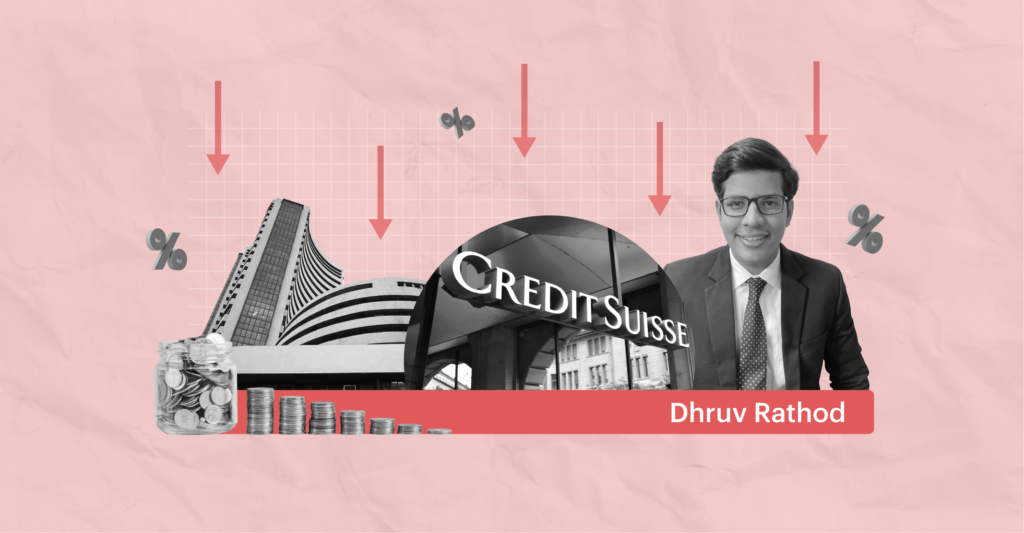Last Updated on Nov 9, 2022 by Anshiya Tabassum
In the past few weeks, you may have heard about how Credit Suisse, an influential bank, is in crisis. The bank’s stock has fallen by more than 60% in the last 1 yr. The bank’s shares have been hammered constantly, and investors have been buying Credit Default Swaps (CDS) of the Credit Suisse loans. So, the share prices have been seeing new lows, and the CDS has been seeing new heights.
Source – Investing.com
Table of Contents
What went wrong at Credit Suisse?
To understand this, we need to understand the 2008 Lehman Brothers crisis or the better-known 2008 Housing crisis. 2008 was the time when American banks failed badly due to high bad debts.
Mortgage-Backed Securities and Credit Swaps
How did the banks end up in so much debt? The reason was the Mortgage-Backed Securities and Credit Default Swaps. Now let us understand CDS with an example.
10 home buyers want a loan of Rs. 1 cr. each. The bank lends them the money to buy houses. But the bank does not lend its own funds, it borrows from an institution or an investor. The investor gives the bank Rs. 10 cr., which it then lends to borrowers at 12% interest. The bank pays the investor about 8% interest and retains the remaining 4%, which becomes its profit. This is mortgage-backed security where a bank gives out a group of loans and sells it to another party. Investors of mortgage-backed securities get returns, and banks get profits.
Investors are assured that the bank lends to credible borrowers. The bank is happy with profits, and borrowers are happy with their houses. It seems like a win-win situation. But as more and more loans were being demanded, the banks worried about people not paying their mortgages on time. So they went to institutions that would insure their mortgage-backed securities at a premium charge. That way, even if the borrowers failed to repay loans, the institutions that insured these mortgage-backed securities would pay back the loans.
The problem was the institution was very sure that no one would default on their mortgages so they insured these mortgage-backed securities with institutions like Lehman Brothers and Morgan Stanley at a very cheap premium. Given the low premium, banks started carelessly lending money and insuring their mortgage-backed securities. Once prices and rents of houses started going down, people started defaulting.
Now, the premiums collected by institutions like Lehman Brothers were not enough to repay the loans. So they started going bankrupt. According to a case study in Investopedia, Lehman Brothers underwrote mortgages of about $85 bn, four times its shareholder’s equity. As these insurers went bankrupt, they couldn’t cover the bad loans. As a result, banks also went bankrupt, and so did investors. Thus, the domino effect started.
In the present day, people started going back in history and comparing the Credit Suisse crisis to the 2008 global financial crisis because the main reason for both crises was the Credit Default Swaps. According to some sources, the premium on Credit Suisse CDS increased even higher than in 2008 recently.
CDS wasn’t the only trigger for the Credit Suisse crisis
If you think CDS was the only problem, that’s not right—aggressive lending was another issue. Credit Suisse took two wild bets. It made clients lend money to Greensill Capital, a financial services company involved in supply chain financing. Greensill and its subsidiary Greensill Bank had major exposure in the GFG alliance of Sanjeev Gupta. He is the executive chairman of the GFG alliance, which has a range of global businesses run by his family the major businesses are steel and Mining. According to a report from Reuters Greensill defaulted on loans of $140 mn from Credit Suisse.
Second, a family office named Archegos Capital decided to finance their trades of risky stocks with Credit Suisse. When these trades went into losses, the fund collapsed and defaulted on the margin calls. The amount was about $5.5 bn. Apart from Credit Suisse, Morgan Stanley and Nomura were also impacted. To make up for it, the banks started selling shares of media and entertainment companies Archegos had invested in.
According to a press release, Credit Suisse also had to settle legacy disputes summing up to $275 mn with regulators of the USA, UK, and Switzerland.
Is the Credit Suisse crisis the same as the 2008 financial crisis?
Credit Suisse is the only bank struck by the crisis. There is a high probability that government would intervene as this bank is too big to fail. If Credit Suisse goes bankrupt, it will have a domino effect on many dependent organizations, pushing them into bankruptcy. To prevent this, Credit Suisse is considering selling profitable businesses to get out of this tough situation.
In my opinion, comparing the two events may not be exactly right because, in 2008, every major financial institution had exposure to mortgage-backed securities and institutions that insured or underwrote these went bankrupt. To end this, the government had to intervene and bail out these institutions to retain people’s trust in these banks.
Will the Credit Suisse crisis impact India?
Even if the bank goes bankrupt (which doesn’t seem possible as the government would intervene), the impact on the Indian economy would be temporary as it is a very small part of the Indian banking system. In contrast, there were many financial institutions involved in the GFC contagion in 2008, but this time, it is just Credit Suisse.
It may come to you as a surprise, and a pleasant one, that Credit Suisse’s Indian entity is in a comfortable position.
Still, experts believe that the Indian market might see an impact on flows and sentiment, which can cause volatility.
Only time will tell to what extent the government will intervene to bail out Credit Suisse and get it out of this mess.
Sources
Press Release – https://www.credit-suisse.com/about-us-news/en/articles/media-releases/finma-mozambique-observation-202110.html
Reuters report of Greensill Default – https://www.reuters.com/business/finance/credit-suisse-appoints-receivers-recover-140-mln-greensill-loan-2021-03-10/
Investopedia Case study – https://www.investopedia.com/articles/economics/09/lehman-brothers-collapse.asp
Stock Prices data – https://in.investing.com/equities/credit-suisse
- Sovereign Gold Bonds (SGBs) – A Smart Alternative to Gold Exposure - Jul 12, 2024
- Navigating the Debt Trap: Lessons from Business Failures - May 30, 2024
- Utility of Wealth in Gen Z and Their Spending Patterns - Apr 30, 2024




